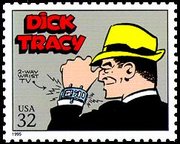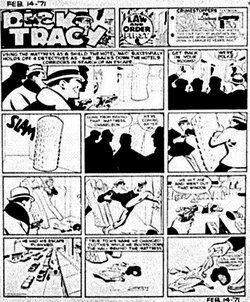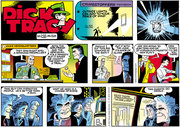Dick Tracy
Dick Tracy is a popular character in American pop culture. The character of Dick Tracy is a hard hitting, fast shooting, and supremely intelligent police detective who has matched wits with a variety of often grotesquely ugly villains. more...
Dick Tracy was created by cartoonist Chester Gould in 1931 for a newspaper comic strip also entitled Dick Tracy. The strip, which made its debut appearance on October 4th, 1931, was distributed by the Chicago Tribune Syndicate. Gould wrote and drew the strip until 1977.
The comic strip
Early years
Chester Gould introduced a raw violence to comic strips, reflecting the violence of 1930s Chicago. Gould also did his best to keep up with the latest in crime fighting techniques and, while Tracy often ends a case in a shootout, he uses forensic science, advanced gadgetry, and plain hard thinking to track the bad guy down. It has been suggested that this comic strip was the first example of the police procedural mystery story. Others have noted that actual mystery plots were relatively rare in the stories since the comic strip format is a difficult one for that kind of plot. The real focus, they argue, is the chase with the criminal seen committing the crime and Dick Tracy figuring out the case and relentlessly pursuing the criminal who becomes increasingly desperate as the detective closes in.
The strip's villains are arguably the strongest appeal of the story. Tracy's world is decidedly black and white where the bad guys are sometimes so evil, their very flesh is deformed to announce their sins to the world. The evil sometimes is raw and coarse like the criminally insane Selbert Depool ("looped" spelled backwards, typical Gould). At other times it is suave like the arrogant Shoulders, who can't help thinking that all women like him. It can even border on genius like the Nazi spy Pruneface who is not only a machine design engineer but also dabbles with a chemical nerve gas.
However, by far the most popular villain was Flattop Jones, a freelance hitman who had a large head that was as flat as an aircraft carrier's flight deck. In a classic storyline, Flattop was hired by black marketeers to murder Tracy and he came within a hairsbreath of accomplishing that before deciding to blackmail his employers for more money before he did the deed. This proved to be a fatal mistake since it gave Tracy time to signal for help and he eventually defeated his assassin in a spectacular fight scene even as the police were storming the hideout. When Flattop was eventually killed, fans went into public mourning.
Reflecting some of the era that also produced film noir, Gould tapped into the existential despair of the criminals as small crimes lead to bigger ones and plans slip out of control and events happen sometimes for no reason at all because life can be unpredictable and cruel. Treachery is everywhere as henchmen are killed ruthlessly by their bosses and bosses are betrayed by jilted girlfriends and good people in the wrong place at the wrong time are gunned down.
Evolution of the strip
Gould changed Tracy with the times, sometimes with mixed results as with the introduction of science fiction elements such as the two-way wrist radio which proved to be the first of a variety of personal wrist communicators and other futuristic gadgets provided by the eccentric industrialist, Diet Smith. This eventually led to what Gould thought was the logical conclusion in the 1960s of the Space Coupe, a spacecraft with a magnetic propulsion system. This started a much-derided science fiction period that had Tracy and friends having adventures on the moon and meeting the late Moon Maid and her race in 1964. This in turn led to an eventual sharing of technologies and the villains had to be even more exaggerated in power to challenge Tracy in an escalating series of stories that completely abandoned the urban crime drama roots of the strip. Finally, Junior actually marries the Moon Maid, and they produced two children! In the 1970s, Gould even less successfully tried to modernize Tracy by giving him a longer hair style and mustache, adding a supposedly "hip" sidekick, Groovy Grove.
More successful was the decades-long substory of the Plenty family, a group of goofy redneck yokels headed by former villains, Bob Oscar "B.O." Plenty and Gravel Gertie. The family provided a humorous counterpoint to Tracy's adventures. Their daughter, Sparkle Plenty, first gave the strip an infant character, and later a pretty young adolescent girl character, since, unlike most comic strip children, she was allowed to grow up. Another successful addition was that of Lizz the Policewoman as one of Tracy's sidekicks. She proved be to an active and formidable female character in a manner that was groundbreaking for comic strips of that era.
However, the later stories were often shackled with a stubborn grousing condemnation of the rights of the accused which often involved Tracy being frustrated by criminals because of legal technicalities and prosleytizing about it. The fact that newspaper comics were sharply reduced in space for each feature during that time also negatively affected Gould's storytelling abilities as he failed to adjust.
The strip often included a frame devoted to "Crimestoppers' Textbook", a series of handy illustrated hints for the amateur crimefighter; for instance, when attempting to memorize the face of an evildoer for later identification purposes, make sure to note the size and shape of the ears and earlobes.
Later years
Gould retired from the strip in 1977 and Dick Tracy was taken over by Max Allan Collins and longtime Gould assistant Rick Fletcher. Collins reversed some of Gould's science-fiction changes by having the character Moon Maid killed off in 1978, as well as doing away with other Gould creations of the 1960s and 1970s, and generally taking a less cynical and simplistic view of the justice system. Rick Fletcher died in 1983 and was succeeded by Dick Locher, who had assisted Gould on the strip in the late 1950s, early 1960s. In 1992, Tribune writer and columnist Mike Kilian took over the writing; Kilian died on October 27, 2005.
Read more at Wikipedia.org



